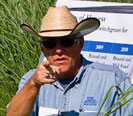Forage Road Trip September 6, 2016 |
| By Hay and Forage Grower |
|
|
Visits to Texas, Kentucky, and Pennsylvania Vanessa Corriher-Olson After a week of much-needed rainfall in east Texas, producers began battling fall armyworms in pastures and hay meadows. As temperatures begin to drop over the next several weeks and with potential for scattered rainfall, producers must continue to scout for fall armyworms. Rainfall also allowed for additional hay cuttings throughout most of the state. Come late September/early October many producers in east and central Texas will begin preparations for cool-season forages. In the Rolling Plains and the Panhandle, preparations for cool-season crops such as wheat have begun.  Ray Smith  Tom Keene As we all know, alfalfa has a tremendous ability to survive and be productive under dry conditions, but this summer was one of the wettest ones on record for much of Kentucky. A number of producers sent samples of diseased alfalfa into the University of Kentucky Plant Diagnostic Lab, especially from seedling stands. The lab reported cases of root rot/seedling blight (Aphanomyces, Phytopthora) early this growing season. Extension specialists also suspected damping off/seed rot (Pythium, Fusarium) based on field observations. Normally, fungicides on coated alfalfa seed prevent most seedling diseases, but the wet/humid conditions may have overwhelmed the seed treatments in many fields. The UK diagnostic lab reported a tremendous amount of summer black stem (Cercospora) this summer. This disease is not uncommon in Kentucky, but this year it showed up early and continued throughout the season. The lab also had cases of Rhizoctonia web blight, which is definitely unusual in Kentucky and indicates very wet/humid conditions. There is no genetic resistance to either summer blackstem or Rhizoctonia, but good management normally allows alfalfa to survive these diseases. Some stands were so severely affected that they had to be replanted or will have to be taken out of production.
We expect the disease load during 2016 is a “one time” event, and the climate will return to more normal conditions in future years.  Jessica Williamson Much-welcomed rain showers have graced the state over the past few weeks, alleviating one of the driest summers in recent history in some parts of Pennsylvania. Pastures and hayfields are gaining some fall regrowth and second-cutting grass hay is being made across the state, where just weeks ago a second cutting was nowhere in sight. However, the rain came too late for much of the state to save the corn crop, and silage yields are expected to be far below normal.
Corn silage is beginning to be harvested across the southern half of the state with dry-down rates nearing optimum toward the central portion of Pennsylvania. Silage harvest should begin in central Pennsylvania this week. Fall oats and winter small grains for emergency forage are being planted following corn silage as forage yields are reportedly low due to the lack of precipitation this summer. |
